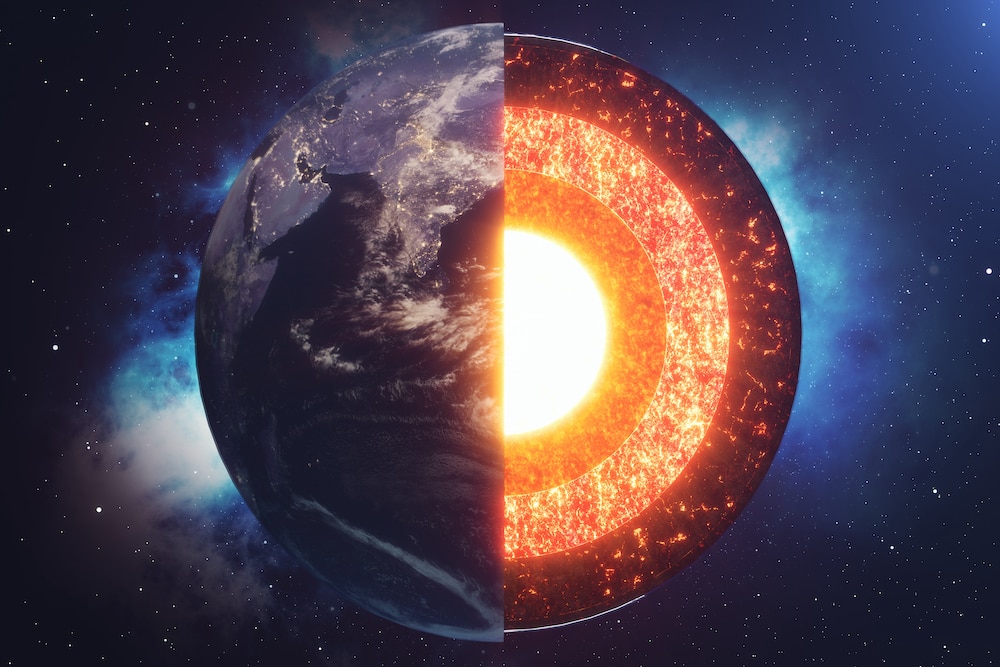Create a free profile to get unlimited access to exclusive videos, sweepstakes, and more!
Is a treasure trove of stuff from Earth’s formation just waiting to be found in its depths?
Deep in Earth’s mantle, near the core, are strange layers that are most likely leftovers from its formation.

What actually exists near the center of the Earth may be even weirder than the monster mushrooms and Dimetrodons that explorers found in that movie.
Deep in Earth’s mantle, near the core, are strange layers that are most likely leftovers from the processes that shaped Earth as it was being formed, including the epic crash that supposedly formed the Moon and flooded our planet with a vast magma ocean. Not all of these layers are made of the same stuff. Whatever they are made of could give us a not only a virtual journey to the core, but also take us back billions of years to when Earth was born.
But how can you possibly get an idea of what lies thousands of miles underground? Seismic waves were the portal to the past for researcher Surya Pachhai, who led a study recently published in Nature Geoscience. There is still no way to actually see what is going on so far beneath the crust. The closest we can get is tracing where seismic waves (the energy that earthquakes generate) and figuring out what they passed through in reverse.
“The seismic wave speeds we measure are directly related to material properties that we can measure in the lab,” Pachhai told SYFY WIRE. “So, if we can measure the wave speed then we can possibly infer what the material actually is. Those materials could also be the material sitting there from the early stage of our planet’s origin.”
The denser the material a wave is passing through, the slower that wave will get through it. Different speeds can give away the properties of different substances and possibly tell us what might be hidden in the bowels of the Earth. Right above the core are zones known as ultraslow-velocity zones (ULVZs). What they actually are remains a mystery, but they are thought to be material that is either somewhat molten or iron-dense because of the degree to which they slow down the velocity of seismic waves that struggle to make their way through them.
What separates Pacchai’s study from previous investigations is that this is the first time researchers have been able to infer the robustness and properties of the layered materials. They were also able to measure the density of the layers, which has been notoriously difficult. Density doesn’t sound like much until you realize it could give away more about the mostly unknown chemical composition of these layers that have been there since the dawn of the solar system. It can also trace the origin of the materials in those layers. Mind blown yet?
“Our discovery of velocity and density gradients within ULVZ argues that the ULVZs are not homogeneous but contain interesting internal structures which bring us closer to learning both their origin and the nature of mixing at the bottom of the mantle,” said Pacchai.
Molten magma doesn’t just stay there, either. It is a dynamic substance that is always moving and changing, and density can be a way to find out what is going on in the superhot liquid. This was another hint that there were hidden layers close to the core. If the density was much lower, that would have meant everything had mixed thoroughly, so there would be no reason to believe layers existed. Before and after the Moon-forming impact, materials that shaped what is now our planet would ultimately sort themselves out, with denser layers sinking to the bottom.
More evidence to support this is the observed increase in density and associated decrease in velocity as you go further down through these layers. This only happens because they are heterogeneous. Until we can develop some sort of robotic contraption to burrow that deep and actually take the heat in there — which can burn over 9,000 degrees Fahrenheit — models and measurements are the only way to travel back in time. During the impact that formed the Moon, intense heat caused the magma ocean to crystallize and boosted the amount of iron.
“In this approach, we make predictions of what the seismic waveforms look like from computations,” Pacchai said. “We can create a model of the Earth that includes ultra-low wave speed reductions, then run a computer simulation that tells us what the seismic waveforms would look like if that is what the Earth actually looked like.”
The origins of the materials in ULVZs have been so elusive because more measurements from more regions on Earth are still needed, especially from earthquakes and subduction events. We’re just going to have to (proverbially) dig more.


























